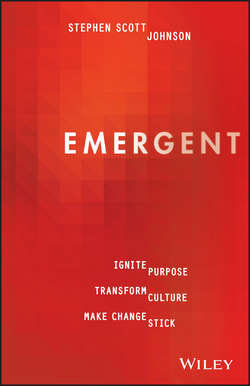Читать книгу Emergent - Johnson Stephen Scott - Страница 6
На сайте Литреса книга снята с продажи.
Foreword
ОглавлениеIn a world now characterised by an inextricable symbiosis with technology, never before has transparent and raw humanity been so vital to leadership, business and society.
Organisations the world over are being challenged to retain their relevance, value and talent within a maelstrom of technology and societal change. For leaders of such organisations, the ability to give an ever-fixed mark, a beacon if you will, to their team and to their stakeholders is essential to guide them through the storm. But as a leader, how do you have the confidence that your light is guiding them away from the rocks rather than toward them?
I’m yet to meet a successful leader who, either systemically or periodically, doesn’t suffer from a level of Imposter Syndrome (unless they suffer from complete delusions of grandeur). The need for external thoughts and wisdom can’t simply come from within their executive team or even from their board. Building out their broader eco-system and leveraging from many sources and data points is the only way to successfully assuage their isolation and allow for the non-sequiter idea that couldn’t be imagined or theorised from within the construct of the organisation. The ability to imbue innovation, bottle kismet and codify purpose in a company is the mark of success in the contemporary business landscape.
So, how is this addressed? Transparency. Radical transparency.
Radical transparency is at the core of 21st century leadership. And without the humility to accept, embrace and enact the vulnerability that is a pre-requisite for such transparency, leadership remains an austere façade that is a barrier to inclusivity. Inclusivity is now the hallmark of wise decision-making as it allows for the diversity of thought that provides decision-making with greater rigour. It generates a more robust process and minimises the risk of fateful, flawed navigation.
Many leaders are also conscious of change fatigue and use this as an excuse to not take their companies into unchartered, or lesser known, waters. This is certainly worthy of due attention but its precursor state – ambiguity fatigue – is also a toxin. In the right dosage, it’s crucial in order to allow the experimentation and adoption of new ideas. Too much and everyone begins to lose direction and faith. But by bringing your stakeholders and customers into the conversation, which is only possible through a leader’s admission that they, and their teams, don’t hold all the answers, co-ownership of the solution becomes possible. This attitude of co-creation is the active ingredient in the antidote for each endemic malaise the threatened company faces – leadership isolation, groupthink and stakeholders’ ambiguity fatigue.
Co-creation is the route to a sustainable culture of innovation. Emergent, at its simplest, is a template for the adoption and installation of co-creation.
Having sat on boards for around 20 years, I’ve naturally become familiar with using a risk register as the core artefact of corporate governance and the maintenance of stakeholder value. But this defensive posture frequently neglects the address of growth or rebirth. The risk of doing nothing never appears on a risk register and yet it is likely to be the greatest threat of all. Perhaps we should all instead create a new artefact that has a more positive stance – maybe a reward register? We certainly need to find new ways of retaining institutional memory while obviating the recidivist nature of large companies where they consistently backslide to previous modalities and shy away from the challenge of disrupting themselves.
Understanding where your company is at ‘now’ is pivotal to beginning the journey in this regard – Stephen’s Culture Quad-rant speaks to this and enables leaders and their teams to assess their current capability in order to plot a path to self-regeneration. In the process, shifting their perspective from one that is only risk-focused and beginning to focus on acknowledging the need for change and its potential rewards.
And, for the sake of absolute clarity, the rewards are not merely commercial. Societal value or social capital is also ‘front of mind’ for the prescient organisation. The Catalyst Engagement System detailed in this book provides you with the lens to see to the heart of this and capture your true values. Tactics and sales are transient; purpose and meaning are evergreen. Unless you are also striving to leave a legacy of societal impact then you’re just a bank account with debits and credits. And a company with an outlook that clinical simply will not resonate with its customers over the long haul. Especially in an emerging landscape where the most valuable companies in the world are ones with the minimal tangible assets in relation to their market capitalisation. Their value is an embodiment of goodwill in the brand and their connection to stakeholders and customers.
I’ve worked with Stephen, and counted myself fortunate to be his friend, for nearly a decade across a number of companies. His personal values and his diverse experience provide him with a vast knowledge of business and large-scale social change. This book isn’t hot-housed theory. It’s extracted from his personal fossil record in business and provides us with a unique perspective on organisational transformation, the development of corporate empathy and the need to inculcate systemic innovation.
Emergent is for leaders seeking enlightenment and a pathway to sustainable organisational success through the awakening, and confluence, of co-created purpose, vision and value. So, read on; embrace its principles; and enact them at your earliest opportunity.
Ashley Howden CEO, KJR (and ambassador for authentic leadership)
